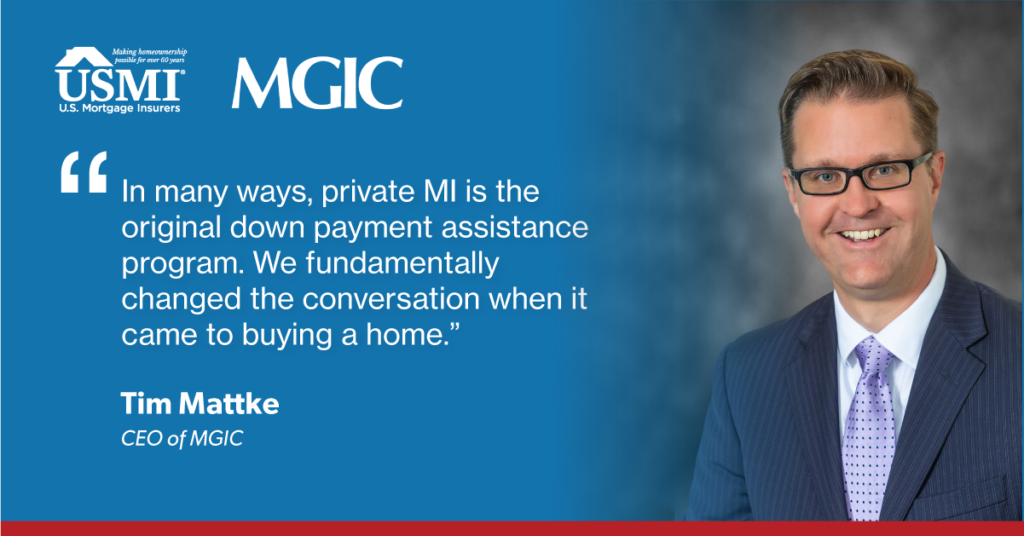We are well into Spring and there continues to be numerous developments in housing finance. April is Financial Literacy Month, so U.S. Mortgage Insurers (USMI) has been hard at work highlighting the unique role private mortgage insurance (MI) plays in the mortgage finance system and the importance of financial literacy in the homebuying process. Washington policymakers have also been busy moving forward confirmations of key administration officials as well as holding congressional hearings and introducing legislation on housing. Below are some of the key developments USMI has been following over the last month.
- USMI Member Spotlight: MGIC CEO Tim Mattke Talks Financial Literacy
- 2020 Numbers Are in: Private MI Industry Record Year in Mortgage Originations
- House Financial Services Committee Holds Hearing on Equitable and Affordable Housing Infrastructure
- HUD Maintains Pricing on FHA’s MI Premiums
- What We’re Watching: National MI CEO Claudia Merkle Explains Private MI
- What We’re Listening To: USMI President Lindsey Johnson on Housing Wire’s News Podcast
USMI Member Spotlight: MGIC CEO Tim Mattke Talks Financial Literacy. Earlier this month, USMI talked with MGIC CEO Tim Mattke about the company’s efforts to ensure first-time homebuyers have access to the right information and resources to be “mortgage-ready.” Mattke noted that “understanding the process” is the most difficult step, after finding the right property, among those aged 22 to 40, according to the National Association of REALTORS®. “To help overcome this challenge, MGIC has provided homebuyer education for decades,” said Mattke, adding that “[l]ast year alone, over 100,000 people took our online tests in English or Spanish. More recently we launched a consumer site, Readynest,” which serves “to demystify the homebuying journey through relatable explanations and stories of others who have gone through the process.”
Mattke also called on federal policymakers to recognize the importance of low-down payment lending, especially for minority, lower-wealth, millennial, and first-time homebuyers. He noted the need to address the shortage in supply to increase affordable housing options and encouraged policymakers to explore ways to reduce regulatory red tape for new home construction and incentivize increased remodeling and rehabilitation of distressed properties.
2020 Numbers are in: Private MI Industry Record Year in Mortgage Originations. In late March, USMI announced a record year for the private MI industry, having helped over 2 million low down payment borrowers secure mortgage financing in 2020, a 53 percent increase from the previous year. Of these, nearly 900,000 were first-time homebuyers, up 25 percent from 2019. The industry supported $600 billion in mortgage originations — approximately 65 percent of this volume was for new purchases while 35 percent was for refinanced loans. This resulted in nearly $1.3 trillion in outstanding mortgages with active private MI coverage at year’s end, underscoring the industry’s critical role in enabling American families to obtain affordable and sustainable low down payment mortgages. “Despite the unprecedented challenges presented by the COVID-19 pandemic, conventional loans backed by private MI continued to make the dream of homeownership a reality for millions of low down payment borrowers,” said Lindsey Johnson, President of USMI.
Johnson also discussed the record volume with National MI CEO Claudia Merkle, who noted two key factors that contributed to the strong production: “First, there are more and more first-time homebuyers coming into the market. They have good credit but struggle to put 20 percent down on their first house. Private MI is a great fit for them. A second factor is attributed to low interest rates, which helped fuel the strong mortgage market momentum in 2020, for both the purchase segment and also for refinances.”
House Financial Services Committee Holds Hearing on Equitable and Affordable Housing Infrastructure. On April 14, the House Financial Services Committee (HFSC) held a hearing titled, “Build Back Better: Investing in Equitable and Affordable Housing Infrastructure.” Several bills proposed by Democratic committee members on issues ranging from lead abatement to broadband infrastructure were discussed. The main proposal, presented by Chairwoman Maxine Waters (D-CA), was the “Housing is Infrastructure Act of 2021.” Chairwoman Waters introduced similar legislation in the past and the 2021 iteration incorporates several of the other proposed bills considered by the committee, including the Down Payment Toward Equity Act of 2021 that would provide for $10 billion in targeted down payment assistance (DPA) for first-generation, first-time homebuyers of up to $20,000 and $25,000 for socially and economically disadvantaged individuals. A recent analysis from the Urban Institute estimates that between 2.51 million and 5.37 million renters households could be eligible for the proposed DPA.
There was also bipartisan agreement among committee members that the persisting shortage of affordable housing is a pressing crisis, and that the nation would benefit from more robust infrastructure investments. The parties, however, differed on what constituted as “infrastructure,” the implications of spending two trillion dollars on President Biden’s infrastructure proposal, and the effect of raising taxes to cover the costs.
HUD Maintains Pricing on FHA MI Premiums. Following the Senate’s bipartisan confirmation of Marcia Fudge as the Secretary of the U.S. Department of Housing and Urban Development (HUD) on March 10, USMI said in a statement that “[i]n HUD Secretary Marcia Fudge, America gains a housing advocate with proven leadership and an accomplished record while serving in Congress and supporting investments in housing programs and community development.” In one of her first actions as HUD Secretary, Fudge announced that the agency would maintain the current pricing of MI premiums on loans backed by the Federal Housing Administration (FHA) due to the agency’s high level of serious delinquency rates and the need to continue focusing on helping the tens of millions of families impacted by the COVID-19 pandemic. USMI President Lindsey Johnson said in a statement that “USMI is encouraged by HUD’s continued support of borrowers impacted by the pandemic, and its focus to ensure an equitable recovery for FHA borrowers. FHA is a critical resource for borrowers to attain homeownership through FHA-backed loans—especially for borrowers who may not have access through the conventional market.”
What We’re Watching: National MI CEO Claudia Merkle Explains Private MI. USMI released a short video of Merkle explaining the role of private MI in the housing market, and how it helps borrowers with down payments of less than 20 percent.
What We’re Listening To: USMI President Lindsey Johnson on Housing Wire’s News Podcast. In April, Johnson was a guest on Housing Wire’s News Podcast to discuss the unique role private mortgage insurers play in helping low down payment borrowers. Johnson also discussed how the industry was well-positioned in 2020 due in part to reforms it had implemented following the 2008 financial crisis. She also highlighted the record year that the private MI industry had through 2020 in helping more than 2 million borrowers purchase or refinance their home. In responding to questions about access and affordability in today’s housing market, Johnson spoke about the challenges of affordability, largely stemming from the lack of affordable housing supply, and spoke about specific proposals that industry and policymakers can pursue together to address these market challenges.











